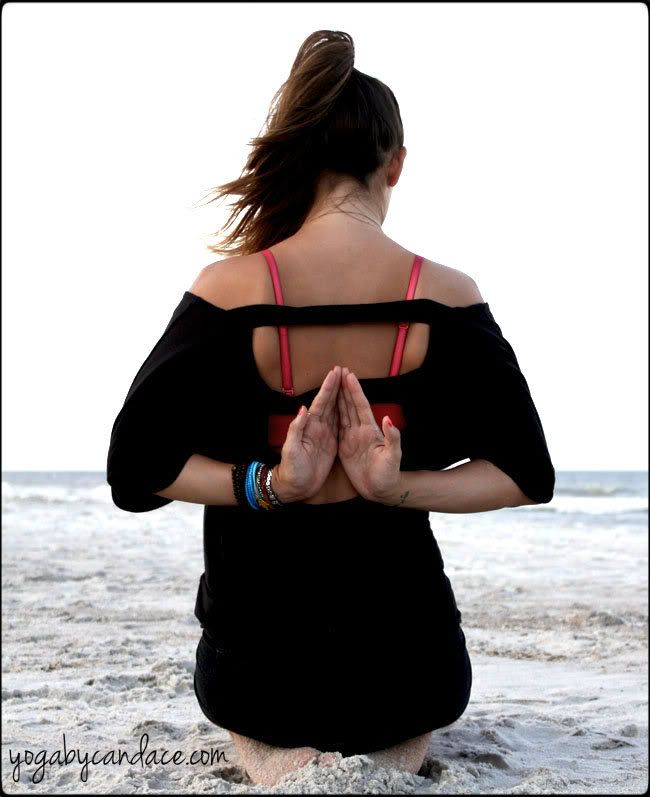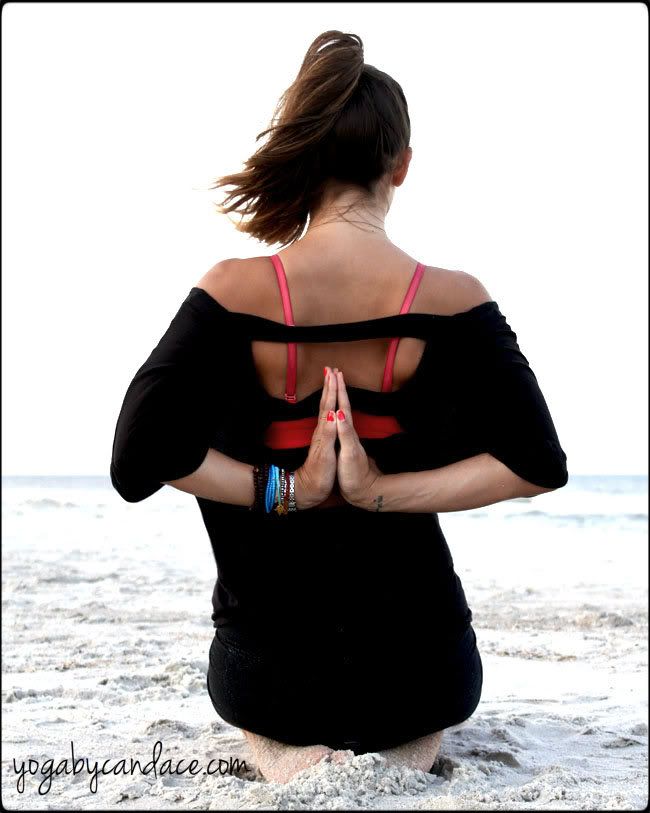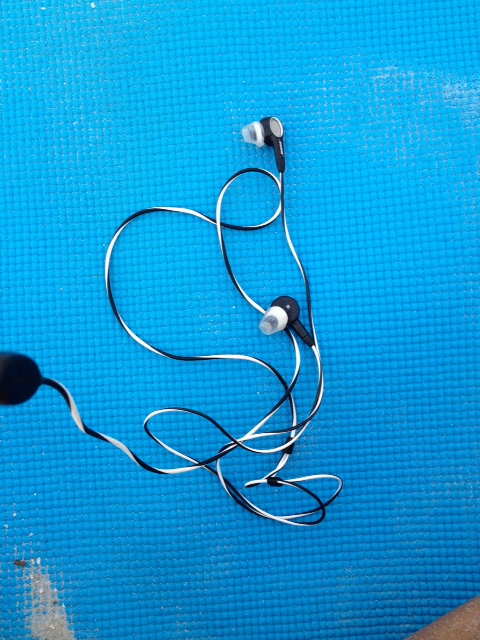Blog
Yoga Tip: Reverse Prayer Hands
Reverse prayer pose, or pashchima namaskarasana, is an intermediate position for the hands. It's great for anyone who deals with wrist pain, and great for the upper back. Plus, sometimes it's just nice to switch up subtle aspects of your practice to go a little deeper.
How to do it:

1. Start standing or seated, spine long. Inhale. On your exhale, bring your arms behind you, fingers pointing towards the ground, palms lightly together. Inhale and rotate your arms so your fingers point towards you, and then to the sky. Your hands may come apart here (like mine do), and that's ok so long as you're moving in a pain-free range of motion.

2. Exhale and lightly press the pinkies into your back as you press your palms together. Collar bones broad, spine long. Breathe here, relaxing into the pose. Come out gently.
Tip: This might be really intense for someone with tight wrists or a tight chest. If you're finding this too challenging, just reach your hands back and, instead of creating prayer hands, spread your fingers wide and lay the back of one palm on your back, and press the back of the second palm on top of that hand. Then, in time, work your way to reverse prayer. Always stay within a pain-free range.
Benefits: Strengthens the wrists and forearms. Stretches elbows and shoulders.
Vegetarian Mexican Dish
After many weeks of the same few meals in rotation, I decided to kick it up a notch. I came up with this Mexican rice and beans dish and it turned out SO good that I had to share. Here's what I did:
Read MoreYoga Tunes: Power Playlist & An Exciting Announcement!
The last yoga music post I did was a mellow, pretty chill playlist. This time I'm featuring a power yoga playlist that is more moody. It's got a some singer/songwriter stuff in there with Fink and Cat Power, and some downtempo electronic stuff with a little homage to the 90's in the form of bands like Garbage and Sneaker Pimps. I've been using it a lot lately during my late afternoon practice. Hope you enjoy it, too.
Slightly related: I wanted to let you all know I'm teaching a Vinyasa Flow & Yoga Nidra workshop next Tuesday (July 24, 2012) in Canaan, Connecticut from 7-9pm. All levels are welcome- I'd love it if you'd join me! $20 if you pre-register, or $25 at the door. Click here for more details and tell all your friends about it on Facebook, too!
Yoga Philosophy: Aparigraha
Aparigraha is such a simple yama (moral attitude) to understand, but I find it's one of the most challenging. In simple terms, according to the yoga sutras, practicing aparigraha (the state of being unattached) will lead to a clear mind. More specifically, it's cultivating that feeling of unattachment to material things, people, ideas, thoughts and actions. Simple, right? But put into action, it becomes apparent how attached we are to... everything. Our car, our clothes, our job, our significant other- the list goes on and on.
Holding onto these things in our life cultivates our sense of identity and therefore, our ego. Anything we label as "mine" can be taken away from us, and ultimately the value we place on these things doesn't serve us.
Take a new car, for instance. You buy a new car, and instantly you're worried about someone scratching it. The new car itself represents a large amount of money and instead of being a way to get you from A to B it becomes a status symbol, a representation of yourself, and fuels your ego. Practicing aparigraha in this instance would mean separating the association of the car and yourself- becoming unattached to the car.
Apart from separating ourselves from attachment to material possessions, we can practice aparigraha by cultivating generosity without expecation of anything in return. When you do something nice for someone, it's vital to let go of any expectations for what you'll ultimately receive, and recognize that the act of doing something kind is the gift.
It's a lot to think about. Don't feel overwhelmed, we're only human. Here are a few questions to ask yourself that may help.
1. What do we need?
Aparigraha is not about letting go of all material possessions. That would be too passive and wouldn't serve you in any way. It's about finding a balance between too much and too little. It's about surrounding yourself with what you need, letting that amount be enough, and not getting attached to those things.
2. What should we focus on?
According to the yoga sutras, we should focus on cultivating a sense of generosity. We should act with compassion and with love. When we give fully of ourselves from this place of love, we let go of our ego, of the stress, fear and worry that attachment brings. This is when we become more in tune with our inner selves.
Read more about aparigraha and other yamas in The Yoga Sutras of Pantanjali:
Thought of the Day: Look Well
An Ancient Sanskrit Poem:
Look well to this day,
for it is life.
In its brief course lie all the realities
and truths of existence.
The joy of growths,
the splendour of action,
the glory of power.
For yesterday is but a memory,
and tomorrow is only a vision,
but today, if well-lived,
makes every yesterday a memory of happiness,
and every tomorrow a vision of hope.
Look well, therefore, to this day.




